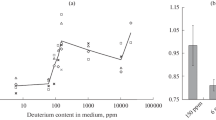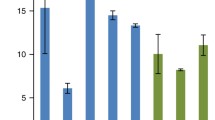Summary
Isolated ventricles of the whelkBusycon contrarium were perfused in 15 mm (internal diameter) nuclear magnetic resonance tubes at 22–24°C. Phosphorus nuclear magnetic resonance (31P-NMR) spectra were generated at 60.7071 MHz using a multi nuclei FT spectrometer. Methodologies were developed to utilize31P-NMR spectra to assess intracellular pH (pHi) and the relative levels of high energy phosphates in experimental preparations. Ventricles perfused under normoxic conditions for 6 h showed no changes in the levels of arginine phosphate and ATP. There was a slight decrease in pHi (0.08 unit). Anoxia and anoxia+ischemia resulted in a number of metabolic changes. There was a linear decay in arginine phosphate with half times of decay of 4.9 and 5.6 h, respectively. Inorganic phosphate levels rose 3–5 fold in both experimental groups. In contrast, no statistically significant changes in the adenylates were observed. 6 h of anoxia and anoxia+ischemia produced significant reductions in pHi. During anoxia, the pHi fell from 7.11 to 6.87, and during anoxia+ischemia the pHi fell from 7.14 to 6.79. Rates of accumulation of succinate and alanine under these conditions were quite low. The apparent low rates of glycolysis were probably related to minimal activities of phosphofructokinase due to reduced pHi and the lack of large alterations in the adenylates. The general response of the ventricle of the whelkB. contrarium to reduced oxygen tensions is a reduction in energy demands leading to low rates of anaerobic energy metabolism and resultant alterations in pHi and levels of high energy phosphates.
Similar content being viewed by others
References
Achs MJ, Garfinkel D (1982) Computer simulation of energy metabolism in acidotic ischemia. Am J Physiol 242:R533-R544
Baginski RM, Pierce SK (1978) A comparison of amino acid accumulation during high salinity adaptation with anaerobic energy metabolism in the ribbed muscleModiolus demissus demissus. J Exp Zool 203:419–428
Barrow KD, Jamieson DD, Norton RS (1980)31P nuclear magnetic resonance studies of energy metabolism in tissue from the marine invertebrateTapes watingi. Eur J Biochem 103:289–297
Bicher HI, Ohki S (1972) Intracellular pH electrode experiments on the giant squid axon. Biochim Biophys Acta 255:900–904
Boron WF, Roos A (1976) Comparison of microelectrode, DMO and methylamine methods for measuring intracellular pH. Am J Physiol 231:799–809
Cobbe SM, Poole-Wilson PA (1980) Tissue acidosis in myocardial hypoxia. J Mol Cell Cardiol 12:761–770
Collicutt JM, Hochachka PW (1977) The anaerobic oyster heart: Coupling of glucose and aspartate fermentation. J Comp Physiol 115:147–157
Dawson MJ, Gadian DG, Wilkie DR (1977) Contraction and recovery of living muscles studied by31P nuclear magnetic resonance. J Physiol 267:703–735
Ebberink RHM (1982) Control of adductor muscle phosphofructokinase activity in the sea musselMytilus edulis during anaerobiosis. Mol Physiol 2:345–355
Ebberink RHM, Zurburg W, Zandee DI (1979) The energy demand of the posterior adductor muscle ofMytilus edulis in catch during air exposure. Mar Biol Lett 1:23–31
Ellington WR (1981) Energy metabolism during hypoxia in the isolated, perfused ventricle of the whelk,Busycon contrarium Conrad. J Comp Physiol 142:457–464
Ellington WR (1982) Metabolic responses of the sea anemoneBunodosoma cavernata to declining oxygen tensions and anoxia. Physiol Zool 55:240–249
Gäde G (1980) The energy metabolism of the foot muscle of the jumping cockle,Cardium tuberculatum: sustained anoxia versus muscular activity. J Comp Physiol 137:177–182
Gäde G, Ellington WR (1983) Energy metabolism in molluscan hearts. (A review). Comp Biochem Physiol (in press)
Gevers W (1977) Generation of protons by metabolic processes in heart cells. J Mol Cell Cardiol 9:867–874
Gillies RJ (1981) Intracellular pH and growth in eukaryotic cells. In: Cameron IL, Pool TB (ed) The transformed cell. Academic Press, New York, p 347
Jacobus WE, Taylor GJ, Hollis RP, Nunnally RL (1977) Phosphorus nuclear magnetic resonance of perfused working rat hearts. Nature 265:756–758
Jarmakani JM, Nagatomo T, Nakazawa M, Langer GA (1978) Effect of hypoxia on myocardial high-energy phosphates in the neonatal mammalian heart. Am J Physiol 235:H475–481
Kostyuk PG, Sorokina ZA, Kholodova YD (1969) Measurement of activity of hydrogen, potassium and sodium ions in striated muscle fibers and nerve cells. In: Lavallee M, Schanne OF, Hebert NV (eds) Glass microelectrodes. Wiley, New York, pp 322–348
Mangum CP, Polites G (1980) Oxygen uptake and transport in the prosobranch molluscBusycon canaliculatum I. Gas exchange and the response to hypoxia. Biol Bull 158:77–90
Neely JR, Morgan HE (1974) Relationship between carbohydrate and lipid metabolism and the energy balance of heart muscle. Annu Rev Physiol 36:413–459
Roos A, Boron WF (1981) Intracellular pH. Physiol Rev 61:296–434
Thomas RC (1974) Intracellular pH of snail neurones with a new pH-sensitive glass microelectrode. J Physiol 238:159–180
Trivedi B, Danforth WH (1966) Effect of pH on the kinetics of frog muscle phosphofructokinase. J Biol Chem 241:4110–4114
Wijsman TCM (1975) pH fluctuations inMytilus edulis L. in relation to shell movements under aerobic and anaerobic conditions. Proc 9th Eur Mar Biol Symp, pp 139–149
Williamson JR (1974) Succinate. In: Bergmeyer HV (ed) Methods of enzymatic analysis, vol 3. Academic Press, New York, pp 1616–1621
Zwaan A de (1977) Anaerobic energy metabolism in bivalve molluscs. Oceanogr Mar Biol Annu Rev 15:103–187
Zwaan A de, Bont AMT de, Zurburg W, Bayne BL, Livingstone DR (1983) On the role of strombine formation in the energy metabolism of adductor muscle of a sessile bivalve. J Comp Physiol 149:557–563
Author information
Authors and Affiliations
Additional information
A brief account of the NMR spectroscopy procedure was reported in the form of an abstract in Am Zool 22:957 (1982)
Rights and permissions
About this article
Cite this article
Ellington, W.R. Phosphorus nuclear magnetic resonance studies of energy metabolism in molluscan tissues. J Comp Physiol B 153, 159–166 (1983). https://doi.org/10.1007/BF00689619
Accepted:
Issue Date:
DOI: https://doi.org/10.1007/BF00689619




